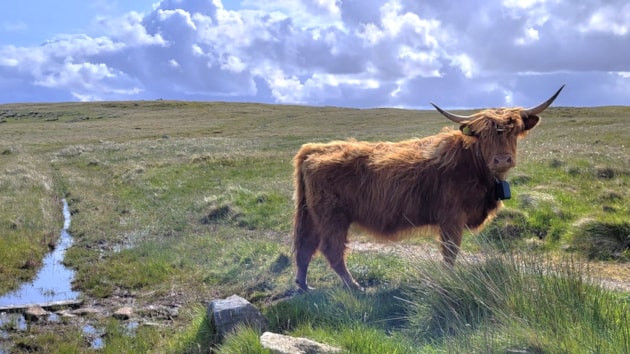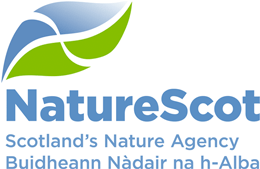25 September, 2025
Modern technology meets traditional crofting to boost island biodiversity

Crofters across Shetland, Ulva and the Outer Hebrides are adopting GPS technology to revolutionise how they manage their livestock, delivering benefits for themselves, their livestock, and local wildlife.
Virtual fence collars are GPS-enabled devices worn by cattle that allow farmers to control where their animals graze without the need for fences. The land manager draws virtual paddocks on a smartphone app and when the cattle approach these invisible boundaries, the collars emit warning sounds. If the animal continues forward, it receives a mild electric pulse (one-third the strength of traditional electric fencing). Within days, cattle learn to respond to the audio warning alone, rarely receiving any shocks.
This technology opens up previously inaccessible grazing areas without the expense and maintenance of traditional fencing. The collars are also beneficial for cattle welfare, allowing landowners to track and monitor their cattle, and the app will send an alert when an animal has been unusually inactive. Crofters can also exclude cattle from unsafe areas, for example boggy areas where the cattle might get stuck.
Cattle grazing is a key tool in conserving important wildlife habitats. As cattle graze, they remove coarse vegetation that competes with wildflowers, whilst spreading seeds and creating bare patches where new plants can establish. This allows a variety of plant species to flourish, which provides nectar sources for pollinators, which in turn attracts birdlife.
Traditional, low-intensity land management has benefitted Scotland’s biodiversity for centuries. Scotland’s coasts and islands, where traditional crofting is still practiced, provide a last refuge for some of the country’s rarest and most vulnerable species, pushed to the edges by the agricultural intensification seen across much of the mainland. Species on the Edge, funded by The National Lottery Heritage Fund, is a programme working with landowners and communities across Scotland to help ensure a future for these species on our shores. The programme has funded a total of 106 collars across Ulva, Shetland and the Outer Hebrides, to support the biodiversity-friendly land management practices that have sustained Scotland’s island communities, and wildlife, for generations.
Species on the Edge Programme Manager, Fiona Strachan, said: ‘It’s great to see this new technology being used across three of Species on the Edge’s areas to help several of our priority species in a way that works for landowners and their livestock too. These collars have great potential for managing habitat that can otherwise be really challenging and we’re pleased to have been able to provide these through Species on the Edge.’
Supporting rare moths in Ulva
Ulva is home to the rare Transparent Burnet moth and the majority of the UK’s even rarer Slender Scotch Burnet moths. However, encroaching bracken is threatening their habitat. Almost nothing eats bracken as it is packed with harmful chemical compounds that grazers and insects mostly avoid. Unchecked, it can grow dense and tall, damaging and crowding-out the species-rich grassland habitats these moths rely on.
Phil Bertin, a farmer on the Isle of Ulva, is using ten virtual fence collars funded through Species on the Edge. The collars have enabled Phil to graze his cattle on the south side of the island where the moths are found, in a vast area of land which he had previously been unable to graze due to a lack of fencing.
Anthony McCluskey from Butterfly Conservation, said: “This technology promises to be a real game-changer for managing sites like these. We have been able to work with Phil to draw up some maps of areas where grazing will be of benefit both to him and his local burnet moths.”
Working with crofters in the Outer Hebrides
Murdanie is a crofter on the Isle of Lewis who, thanks to funding from Species on the Edge, now has a virtual fence collar for each of his cattle. He said: “We out-winter our cows which is tough with the winters we get: lots of mud, loads of silage and concentrate feed. We started using NoFence collars to monitor our cattle and allow them to use unfenced areas, common grazings, and exclude boggy ground. And there is an additional benefit: environmental improvement.
Many people criticise cows as damaging, but by clearing unused crofts and chocked grassland, they allow grass and flowers to come through which is good for a range of species, including bees. More insects attracts birdlife and, by grazing the land, the deer do not want to encroach as near. In the old days when there was a lot of sheep and cows grazing, the deer rarely ventured off the moor. It also means the cows have a much more natural life by rotating round grasslands (we walk them between fields).
There is also visible improvement of the ground after cows have been there. Last year we had them grazing on Airidhantuim Common over part of the winter and the impact in the spring was vast: a great abundance of green grass and flowers.
All in all, the No Fence Collars are beneficial for all! Less feed, more used crofts, more wildlife, no mechanical topping, healthier cattle, and healthier land. We are hoping to identify and graze more areas around where we live over this coming winter.”
Protecting the ‘Shetland Bumblebee’
Shetland is home to one of the UK’s rarest bumblebees: Bombus muscorum agricolae, nicknamed the ‘Shetland Bumblebee’. A subspecies of the moss carder bee, the ‘Shetland Bumblebee’ can be found in Shetland, Orkney, some of the Scottish Western Isles and nowhere else in the world. To thrive, these bees need an abundant supply of nectar-rich wildflowers such as red clover and bird’s-foot trefoil throughout the summer.
Species on the Edge has distributed 46 Monil virtual fence collars among four crofters in Shetland to help with grazing, particularly of sandy dune and grassland sites. There are only a handful of these habitats in Shetland, and, when well-managed, they can provide an abundance of pollinator-friendly plants. The mobile dunes make fencing impractical, and as a result no livestock have grazed these areas for many years.
In the South Mainland of Shetland, four of local crofter Laura Sinclair’s cows have been fitted with collars and have recently started to graze on the sand dunes. This autumn, they will break down a matted layer of plant litter and will open ground for diverse wildflowers to grow next summer.
Laura said: “We are really excited about the collars and are hoping they will allow us to graze areas that don’t have suitable fencing for cattle. It’s also been useful for tracking the cattle and their whereabouts, particularly during calving.”
The collars also enable strategic grazing to help ground-nesting birds like Curlew and Lapwing in Shetland’s wet grasslands. Each species has preferences; Lapwings look for short vegetation that allow them to keep a good view of their surroundings, whereas Curlews need more tussocky ground to hide their nests. The virtual fence collars allow cattle to be enclosed in areas where short vegetation is required for Lapwings and excluded from areas where nests need to be protected.
Contact information
- Name
- Eilidh Ross
- eilidh.ross@nature.scot
Notes to editors
Celebrating innovation in rural land management and conservation to mark Scotland's first National Innovation Week (22 - 26 September).
Available in Gaelic here: Tha teicneolas ùr is croitearachd thradaiseanta a’ cur taic ri bith-iomadachd nan eilean còmhla
Species on the Edge is a multi-partner species conservation programme dedicated to working with communities across Scotland’s coasts and islands to help them secure a future for their local nationally and internationally vulnerable species. Funded by The National Lottery Heritage Fund, the partnership consists of Amphibian and Reptile Conservation, Bat Conservation Trust, Buglife, Bumblebee Conservation Trust, Butterfly Conservation, NatureScot, Plantlife, and RSPB Scotland. The programme is active across seven landscape-scale areas in Scotland: Argyll and the Inner Hebrides; Outer Hebrides; North Coast; Orkney; Shetland; East Coast; Solway Coast. www.speciesontheedge.co.uk
NatureScot is Scotland's nature agency. We work to enhance our natural environment in Scotland and inspire everyone to care more about it. Our priority is a nature-rich future for Scotland and an effective response to the climate emergency. For more information, visit our website at www.nature.scot or follow us on X at https://x.com/NatureScot
’S e NatureScot buidheann nàdair na h-Alba. Bidh sinn a’ neartachadh àrainneachd na h-Alba agus a’ brosnachadh dhaoine gu barrachd suim a chur ann an nàdar. Tha e mar phrìomhachas againn gum bi nàdar na h-Alba beairteach agus gun dèilig sinn gu h-èifeachdach le èiginn na gnàth-shìde. Tha an tuilleadh fiosrachaidh aig www.nature.scot no air X aig https://x.com/NatureScot








